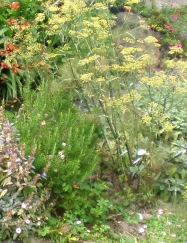Choosing Herb Garden Plants

Herbs are distinguished from other plants by the fact that they are beneficial to man – those that are effective medicines, have good flavoring properties or are nutritious to eat. As such, they can be found amongst most families of the plant world. Most herb garden plants are flowering plants which can be annuals, bi-enniels (plants that develop in the first year and come to fruition in the second) or perennials.
When choosing herb garden plants consider their height and spread as their relationship to one another in the garden is important. Their visual impact can be used to great effect whether you want to integrate them all over the garden amongst other garden plants or not. In a dedicated herb garden design, some herbs are planted to define areas with high or low hedges such as rosemary and lavender. Some varieties of thyme can provide creeping ground cover. Sage oregano and marjoram make attractive mounds. Color and texture come into play too. The tall and airy stems of fennel covered in cloudy leaves and topped with plates of tiny flowers juxtaposed with the downy silver leaves of sage, or tumbling nasturtiums at the base of a shapely rosemary bush are a treat for the eyes.
Your choice of plants will also be governed by why you want them. Do you want them for the kitchen, for medicinal purposes, as pest control for the vegetable garden, to make preparations for the home and cosmetics, or simply to enjoy their fragrance and beauty as you wander about your garden?
Herb Garden Plants for the Kitchen
It is probably most usual when starting out to grow your herbs for the kitchen and to enjoy their fragrance, though many of your herbs will have properties for several or all of their various applications.
Culinary herbs fall into several categories – aromatic leaves, spicy roots and seeds, and flavorings, which are foods in themselves – salad herbs being among the latter. Some of the culinary herbs as well as those with the power to heal can be highly ornamental and are often grown purely for their beauty. Echinacea, famously useful for warding off the common cold, is a beautiful example with its large daisy-like colorful flowers.
Many of the herbs we use come from warm countries and thrive in sunshine which helps to bring out their full flavor and aroma. One need only think of the typical Italian herb garden. These plants flourish in any reasonable soil with good drainage. The soil should not be too rich, though very poor sandy soil will benefit from the addition of plenty of organic material. Garden compost or leaf mold will do very well and only a small amount of fertilizer is needed.
Some plants will rampage over other precious plants if not kept in check. You can plant herbs like mint, lemon balm and soapwort in deep bottomless pots plunged into the earth with the rim proud of the surface to restrain their spread.
Even a garden without a sunny area can be home to some herbs. Chives, mint, parsley and angelica will be fine in the shade. Few will be happy indoors and you should expect to replace indoor plants fairly often although a spell outdoors in the summer will prolong the life of some.
Whatever the size or situation of your own proposed garden, with a little understanding and research there will be the right herb garden plants to grow to achieve your goals.